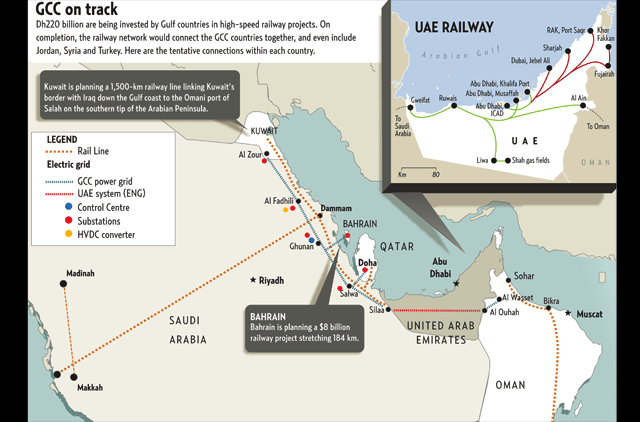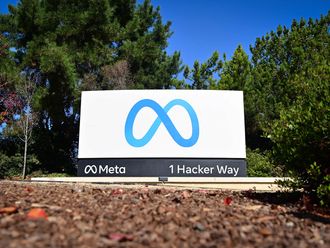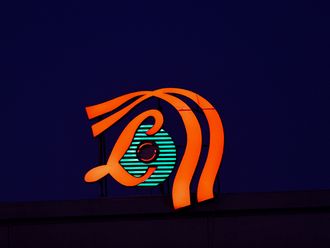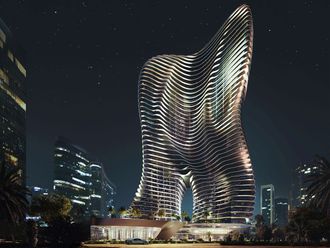
Dubai: The Gulf Cooperation Council (GCC) power grid brings the Gulf states a step closer in their efforts to integrate economies. With the planned GCC railway, GCC Customs Union and GCC Common Market the six oil-exporting Gulf states can now look for greater economic cooperation.
The UAE, which has contributed Dh800 million to the Dh5.1-billion project, said last week that the regional power grid may save participating countries up to Dh18.4 billion ($5 billion) in electricity costs over its lifetime and will lay the foundation for a common GCC energy market.
The GCC was established in May 1981 bringing together six countries — Saudi Arabia, Bahrain, Kuwait, Oman, Qatar and the UAE — to develop and solidify a unified social, political and economic system.
Since then, the six countries have been making several attempts to achieve greater cohesion, for instance, the single GCC currency, which has been put on the backburner for now, followed by the recent efforts to establish an integrated visa system for all GCC countries.
But while all this is still work in progress, the GCC has made definite progress in one area — that of building a power grid for the region.
The $1.4-billion (Dh5.13 billion) project is simply aimed at meeting the rapidly rising power demand and avoiding power outages.
The UAE last week joined the second phase of the three-phase Gulf power grid which became operational on April 20.
The grid, inaugurated by His Highness Shaikh Mohammad Bin Rashid Al Maktoum, Vice-President and Prime Minister of the UAE and Ruler of Dubai, currently links the Al Sala power station with the Salwa station in Saudi Arabia.
Once completed, the GCC interconnected grid will provide electricity across the GCC.
"This would provide a platform for energy trade and exchange, while improving the reliability of existing energy systems and lowering electricity reserve requirements by the GCC countries," Shaikh Mohammad said at the inauguration.
Sustainable supplies
He added that the project will "lay the foundation for a common energy market" among the GCC countries as well as provide the six states with sustainable energy supplies to help their national economies continue growing.
The move unifies the six GCC states with the first phase having become operational in early 2009 connecting Saudi Arabia, Kuwait, Bahrain and Qatar.
The participation of the final member state — Oman — however, has been delayed from this year and it is now expected to join the power grid in two years, according to Eisa Al Kuwari, Chairman of the GCC Interconnection Authority (GCCIA) — a semi-government entity established by the six GCC countries to build and operate a network linking their national power grids.
So while the second phase provides electricity for the UAE, Saudi Arabia, Kuwait and Qatar, the third phase will see the grid linking Oman to the GCC grid.
Investment costs
According to industry experts, the power grid is expected to reduce high long-term investment costs in constructing generating plants by reducing the level of reserves needed in each country as well as providing wheeling services and enabling energy trading.
"The major saving all the participating countries can do is in terms of avoiding investing in power generation. Each individual country can save on power generation by the way of the interconnected grid," Abhay Bhargava, Industry Manager, Energy and Power Systems Practice, Mena, Frost & Sullivan, told Gulf News.
Asked if the yearly saving of $5 billion was a feasible estimate, he pointed out: "Maybe it is in the short term. There can be immediate savings in the region of $5 billion in the five to 10 years period."
Meanwhile, the present demand for electrical power in the GCC countries is approximately 70 gigawatts and is expected to triple over the next 25 years, according to reports.
Penalties
While Saudi Arabia can give and receive 1,200 megawatts, for the UAE it is 900 megawatts and Qatar 750 megawatts, as per industry data.
"Nations are now negotiating to sell power to each other starting from next year and will be penalised in future if they don't maintain a minimum reserve level to support their neighbours in an emergency," Al Kuwari reportedly said.
The Arab League is currently carrying out a study to expand the power grid beyond the GCC and possibly connect it to the rest of the Middle East and North Africa, as well as Europe, according to Al Kuwari.
He added that Saudi Arabia is undertaking a separate study with the World Bank about connecting the grid to Europe.
Objectives: linking up nations
- Link the electrical power networks in the member states by providing the necessary investments for the exchange of the electrical power in order to face the loss of the ability to generate electricity in emergency situations.
- Reduce the electrical generation reserve of each of the member states.
- Improve the economic efficiency of the electricity power systems in the member states.
- Provide the basis for the exchange of electrical power among the member states in such a way as to serve the economic aspects and strengthen the reliability of the electrical supplies.
- Deal with the existing companies and authorities in charge of the electricity sector in the member states and elsewhere in order to coordinate their operations and strengthen the efficiency of operation with due regard to the circumstances relating to each state.
- To follow up the world technological development in the field of electricity and to seek to apply the best modern technologies.
Steps to integration
The GCC Interconnection Grid to be developed in three phases:
Phase I: The GCC North Grid: Interconnection of Kuwait, Saudi Arabia, Bahrain and Qatar.
Phase I of the GCC Interconnection shall link the networks of Kuwait, Saudi Arabia, Bahrain and Qatar:
- A double-circuit 400KV, 50Hz line from Al Zour (Kuwait) to Ghunan (Saudi Arabia) with an intermediate connection at Al Fadhili (Saudi Arabia) and associated substations.
- A back-to-back HVDC interconnection to the Saudi Arabia 380KV, 60Hz system at Al Fadhili. Saudi Arabia is the only country in the Gulf with a system frequency of 60Hz.
- A double circuit 400KV comprising overhead lines and submarine link from Ghunan to Al Jasra (Bahrain) and associated substations.
- A Control centre located at Ghunan and is to be linked with each member country's national control centre.
Phase II: The GCC South Grid: Interconnection of the independent systems in the UAE as well as Oman. Phase II consists of the integration of the isolated networks of the UAE as well as the isolated system of Oman. This combined system is the GCC South Grid. GCCIA is not involved in the execution of phase II.
Phase III: North-South Grids: To link the networks of Kuwait, Saudi Arabia, Bahrain, Qatar (North Grid) and the UAE and Oman (South Grid):
- A double circuit 400KV line from Salwa to Shuwaihat (UAE) and associated substations.
- A double circuit 220KV line from Al Ouhah (UAE) to Al Waseet (Oman) and associated substations.
- A single circuit 220KV line from Al Ouhah (UAE) to Al Waseet (Oman) and associated substations.












